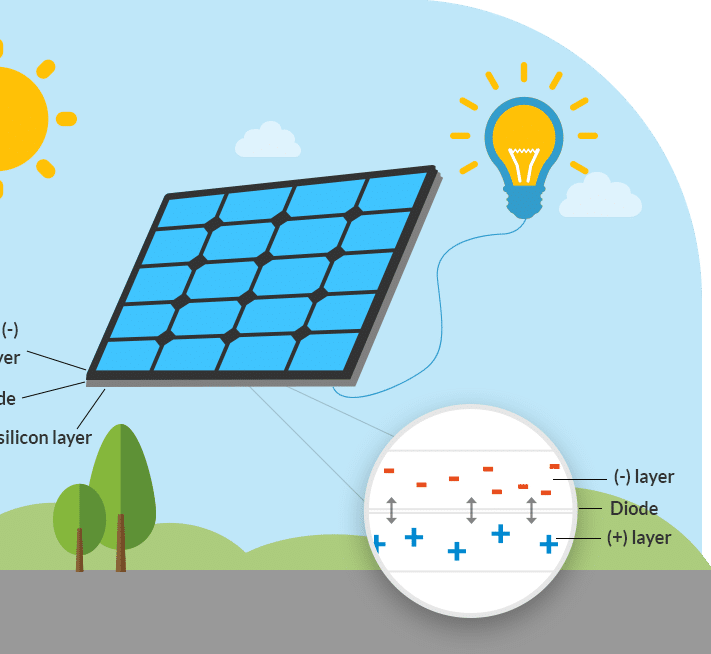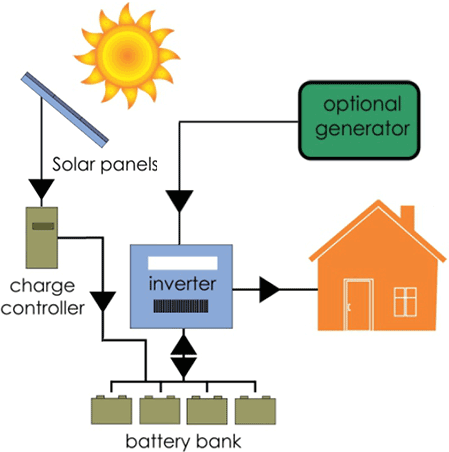Grid-Tied and Off-Grid Solar-Electric Systems
Deciding to install solar on your home or business is hugely beneficial to both your wallet and the environment, but there’s more to it than simply putting panels on your roof. After all, solar power only makes electricity during the day. To figure out how power will be supplied to the building at night or on excessively cloudy days, the owner will have to decide whether or not to “tie” into the utility power grid. This article describes the benefits and potential complications when deciding whether or not to connect your solar system to the utility grid.
Grid-Tied
For most homes and businesses, the building is already tied to the grid for its electrical needs. As a result, having a grid-tied solar system is the most common form of the three described in this article. The benefit to being grid-tied is primarily economical. Grid-tied systems are cheaper than off-grid systems because they don’t require a backup generator or battery bank. By connecting to the grid, you can use it to supply your power when your solar panels aren’t meeting your needs. Staying grid-tied also provides a unique benefit via net metering laws. Some systems are able to generate excess energy during the day. Net metering allows you to sell that surplus electricity back to the utility grid for a credit on your utility bill. This policy allows homes and businesses to have virtually “net zero” energy buildings.
While grid-tied systems have several benefits, there is still a reliance on the utility grid for power when the solar system isn’t producing. Moreover, in the event of a power outage the solar panels will not be able to produce electricity for the building, unless there is a battery backup system in place as well. Without a battery system, the solar system is automatically shut down to prevent voltage from being fed into the utility grid while line workers are fixing the outage.
Off-Grid
In some cases it makes more sense to not tie into the utility grid as the cost for running new transmission lines can be prohibitively expensive. As such, remote areas may benefit from having off-grid solar systems. While such systems are more expensive, they are also more self-reliant and often use a secondary or even tertiary source of power when solar is not sufficient. By storing the electricity generated by the solar system in a battery bank, the building has access to power at night and/or over a few days, depending on the battery’s capabilities. If, for whatever reason, the batteries run out of electricity, off-grid systems will often have a backup generator supply electricity. How long that generator can supply electricity is dependent on access to fuel.
While off-grid solar systems require much more technology to properly power a home or business consistently, the self-reliance may be attractive enough for some. Others may find it simply more cost-effective if they are located far from the utility grid. Keeping proper maintenance of all parts within the off-grid system is crucial in order to prevent unnecessary wear and damage from accruing.
Grid-Tied with Battery Backup
The last method described here is a mix of the previous two. By having a connection to the utility grid but also having a battery backup system installed, the system is even more resilient to outages. If the utility experiences a blackout, power will still be supplied by the batteries for a short period of time. For more information about battery backup, check out our article on Tesla Powerwall battery systems.
Overall, this type of system is cheaper than off-grid systems because utility prices for electricity are often cheaper than fuel for a backup generator. While there is still an additional cost involved due to the batteries, the increased resilience is worth the price to some customers. That price will likely continue to decline as production increases for battery technology.
With more people than ever going solar, it’s important to decide for yourself how you want to power your home or business. But with so many options available, it can get to be too much, and that’s why we’re here to help. Call us or stop by our offices to figure out how solar can help you today.




